The Internet is getting weird again. Twitter’s recent stumbles under new ownership have surprisingly shined a quick light on the world of federated and decentralized social networking services, like Mastodon. These services are peer-to-peer or community-run networks, depending on the particulars. Federated services are services that are managed by individual organizations or “offices,” such as the Post Office, email, or self-hosted forums.
If you were on the Internet “back in the day,” you might remember when everyone connected through a variety of different forums or IM client accounts while having their own personal pages on Geocities or Blogspot. The rise of federated services is reminiscent of that. If you’re used to “modern” social media from 2012 or so onward, all of this can be really confusing at first glance—which is understandable! A lot of jargon is being thrown around, and much of the established norms are being abandoned.
Have no fear! This is your guide to the federated universe (coined the “Fediverse”), and what it all means for you and for the future of social media/networking. Since the biggest crowd of Twitter refugees seems to be heading towards Mastodon, let’s look at what you need to get started there, first. From there, we’ll dive deeper into the underlying concepts and systems that make federated services work, as well as highlight some other specialized networks you can try—like PixelFed and PeerTube—which take that idea beyond mere Twitter clones into a full web experience.
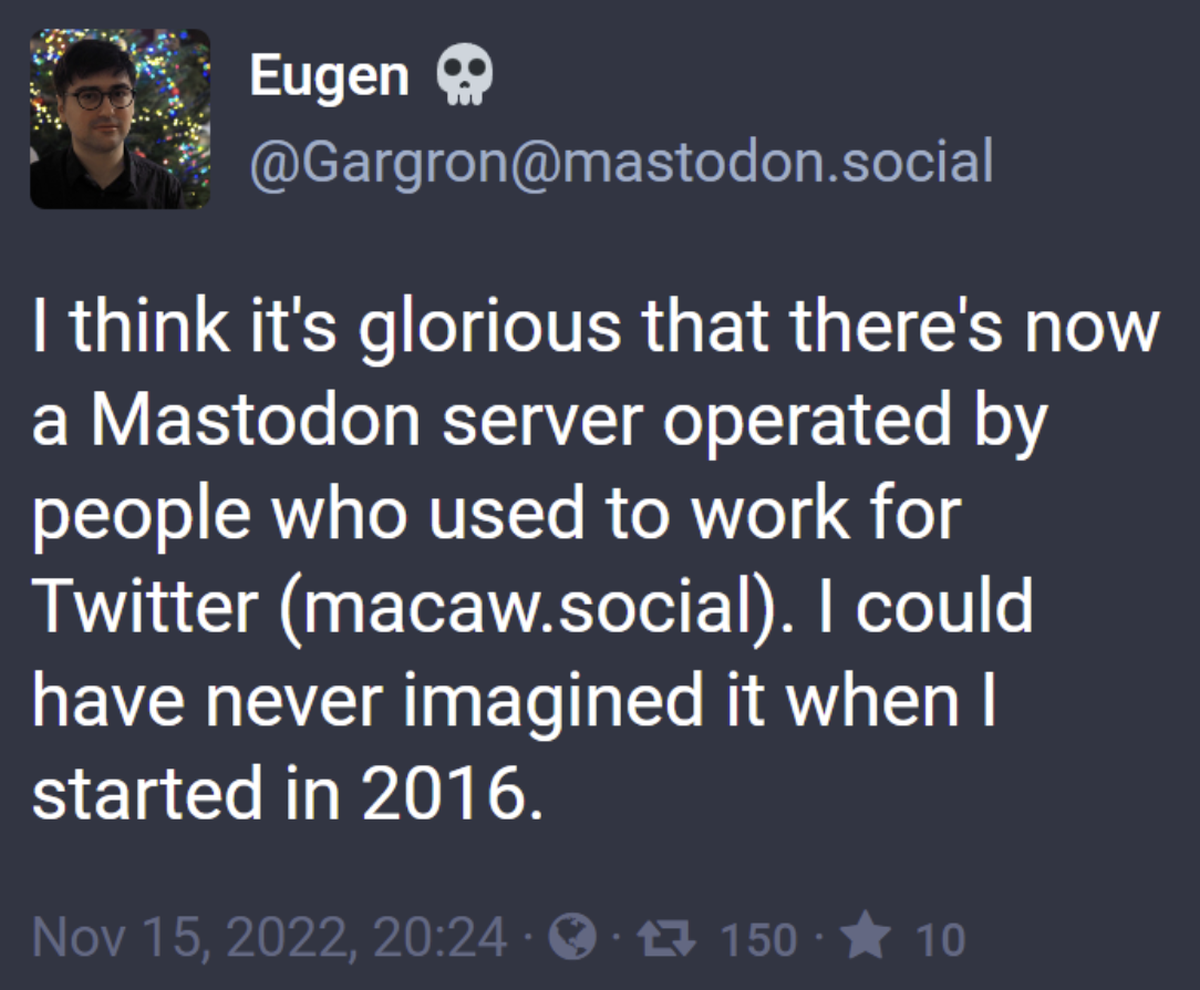
Eugen Rochko is the creator of Mastodon
Adam Taylor/IDG
By the time you’re done reading this you’ll have a full grasp of federated services—and their potential.
Meet Mastodon
Before we jump into the super nitty gritty, let’s take a look at one of the big services gaining traction right now: Mastodon.
Mastodon has been exploding over the past few weeks, with over 1 million new daily active users being involved just since the end of October. According to this Mastodon signup tracking bot, there’s more than 7 million total accounts, with 2000 being made every hour. Momentum is gaining for Mastodon, which has been around since 2016.
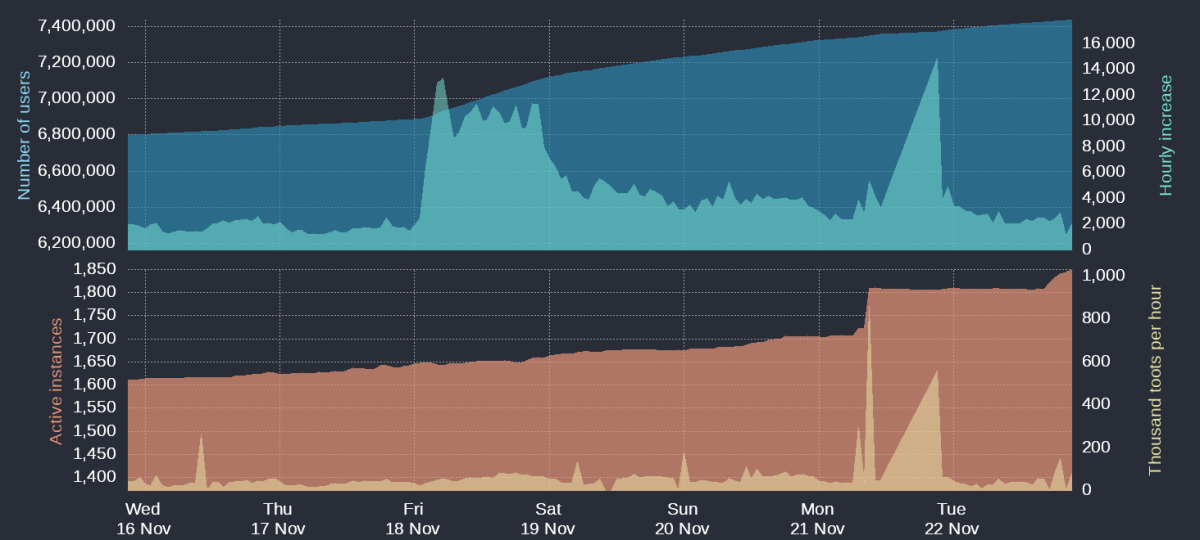
Image via mastodonusercount bot
Adam Taylor/IDG
Mastodon itself is very much a Twitter-like service. It’s a microblogging tool in which you send mostly short-form text posts, a few images or very small (40MB is the current limit) videos, build threads, follow and reply to other people, and “boost” (the equivalent of sharing or Retweeting) posts. There’s also messaging, though it’s not yet as fully developed as many might hope. You’d be forgiven for taking one glance at it and thinking “wow, that’s generic Twitter.” In a way, that’s the point.
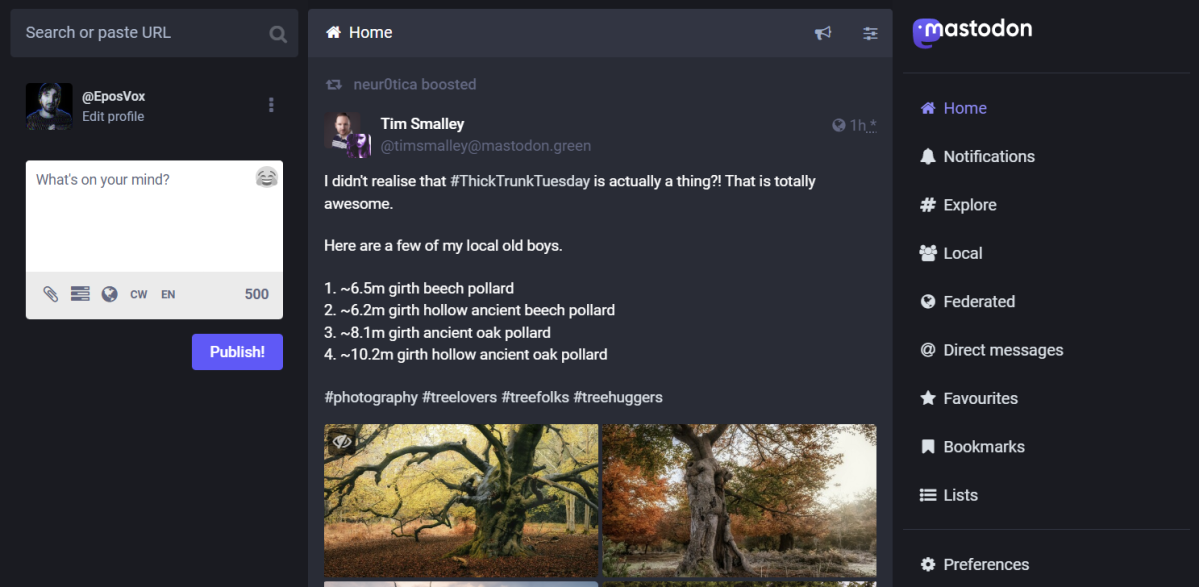
At first glance, Mastodon’s layout very much resembles Twitter.
Adam Taylor/IDG
But Mastodon is missing all the profit-centric bloat of modern social media platforms. There’s no algorithm recommending you content or people to follow. Unlike Twitter or Facebook, where the goal is to keep you glued to the screen as much as possible and never leaving their website, Mastodon is just there to provide a social networking place for you to have conversations. Humans don’t communicate with algorithms by nature. But also, the point with Mastodon is to make friends, not follow brands.
Instead, you get a linear feed of the posts the people you follow make (or boost). When you first join, this means your feed may seem empty or lonely—especially if you’re on the “official” mobile apps. The better alternatives (such as Tusky on Android or Metatext on iOS) feature “Local” and “Federated” timelines to help you find more people. Your individual instance (read: community server) admins may have suggested accounts to follow from that community when you sign up, too. Otherwise, you can search for hashtags and follow them, or follow people posting cool stuff in those hashtags relevant to your interests. If you’re migrating from Twitter, some of the people you’ve followed over there may have publicized Mastodon handles you can follow as well.
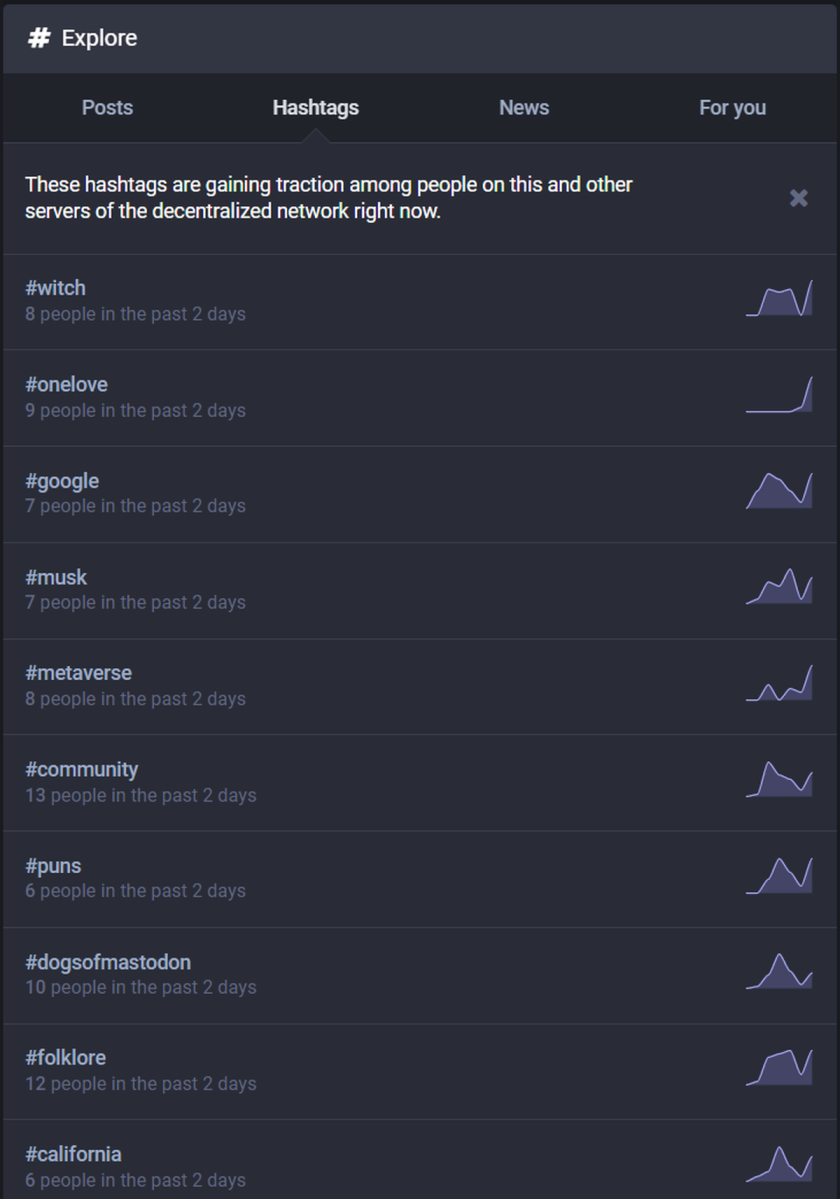
You can still keep your finger on the pulse while on Mastodon, with trending news, links, and trending hashtags showing you what conversations are happening – all approved by your instance admins to help keep the junk out.
Adam Taylor/IDG
In those alternative Mastodon apps, the “Local” timeline will be anyone in your instance, and the “Federated” timeline is a “mutuals” timeline featuring anyone that anyone in your instance, or that you follow, has connections to. Think of it as a “6 degrees of Kevin Bacon” kind of thing. The Federated feed is more akin to the r/all page on Reddit (without upvotes) and is generally not the most fun place to be, but it can be interesting to browse.
You can reply to posts, and replies can be limited in privacy to public (shows up in Home timelines and hashtag searches), unlisted (shows up in followers’ Home timelines and on your profile, but not in Local or Federated timelines or hashtag searches), and private (which only show up to the recipient). You can “boost” posts, which just puts them in your timeline, including Local and Federated timelines. You can also “Favorite” (remember when Twitter called Likes this?) posts—but all that does is just interact with the person. There’s no system that will feature Favorited posts in your feed. Thank goodness.
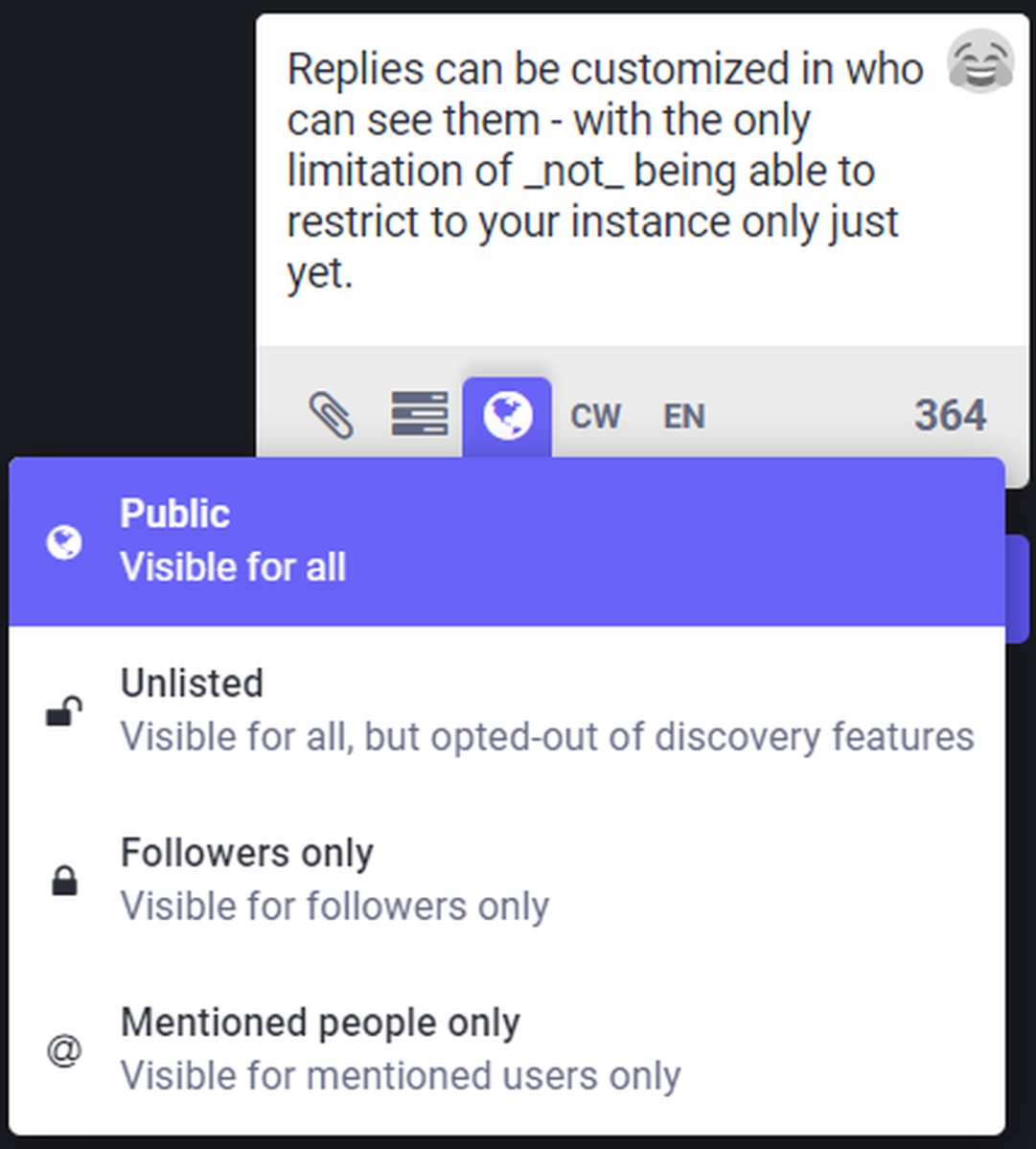
Adam Taylor/IDG
You can add people you’ve followed to Lists and then pin those lists to your “Advanced Web View” located in Options -> Appearance—which is basically like Tweetdeck for Mastodon—and keep better track of different groups of people. You can also pin hashtags or groups of hashtags as searches to your view to follow those as well!
Heck, if you want to embed your Mastodon feed in your blog, you can do that with Mastofeed too.
These stark differences from Twitter make it clear how different Mastodon’s goals are as a service. Which, for one, is to be a service instead of a platform.
Federated Service versus Platform
I’m going to keep referring to these social networking tools as “services” because they are just that: Services instead of platforms. This is one of the major paradigm differences between modern centralized social media and the direction things appear to be heading (which, again, is also where they came from). Twitter is a platform; it’s a singular, centralized hub run by a corporation that controls every aspect of it.
A service is a tool designed to solve a problem for the user (in this case, social networking), whereas a platform is a generic service that hosts other services for different target groups, according to Paylocity CTO Rachit Lohani.
Twitter isn’t a singular service. It has built itself into a business structure offering a variety of services to different groups—including other businesses. It’s a social media site for the users, sure, but instead of earning revenue from its users in exchange for that service, it recoups costs (even if unprofitably) by selling data, ad slots, and other paid tools to businesses.
Nathan Reiff writes on Investopedia: “Twitter divides its revenue into two categories: the sale of advertising services, which constitutes the vast majority of the company’s revenue, and data licensing and other services.” Twitter doesn’t even have a revenue category for “providing a social media app to users,” heh.
With Twitter, social networking isn’t the product. The user is the product, with user acquisition being the goal. With Mastodon, the tool is the product.
Mastodon is a service. There’s no centralized authority or hub: There are bigger, more “official”-like server instances for it, but anyone can host an instance for a community or niche, and are encouraged to, and whoever runs those instances governs their own community (including policies, code updates, and so on). It’s all open-source software, which means community-based development, decision making, modification, and verification. There’s also no advertising, data sharing, or tracking of any kind. Code development and individual community server hosting is funded by the community or the person funding it.
Could a major company build their own Mastodon instance and charge users to join and provide some sort of proprietary or private offering to justify the cost? Absolutely. But that’s not an inherent part of the service itself, and the vast majority of instances aren’t set up that way.
Instances and decentralization
Alright so what the heck are these “instances” anyway? This is where things are going to sound complicated, but I promise they’re simpler than they first seem.
First, let’s cover federation.
Mastodon is just one example of a “federated service.” Federation means using a singular method of authenticating accounts across multiple different services, which can then all talk to each other and share things between each other. Microsoft uses this for Active Directory Federation Services, as do plenty of other enterprise security systems.
OneLogin explains that the difference between federation and SSO (Single Sign-On) is that SSO is used for multiple applications from the same provider or domain, whereas federated identities can be used across multiple different applications, services, or platforms from different providers as long as those services are in the same “federation” enabled to talk to one another.
Simplified, it just means that a bunch of services are built upon the same account foundation to allow you to use the same accounts and communication protocols across each other, so they can all speak the same language.
For Mastodon and other “Fediverse” services, this foundation is ActivityPub: An open, decentralized social networking protocol built by the World Wide Web Consortium. Many of the popular federated services use ActivityPub as their protocol and thus can talk to each other. There’s a comprehensive list of these services here.
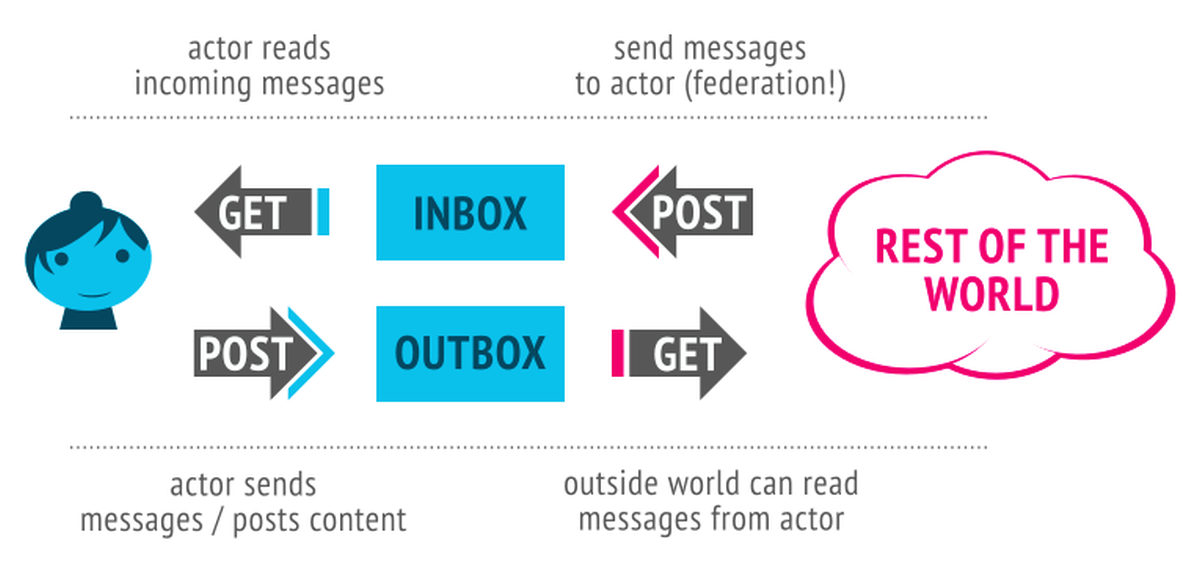
ActivityPub is basically a protocol for sending and receiving messages, but where anyone can host their own servers (or “instances”) as a point for the user to interact with the broader network.
W3C
ActivityPub posts (or Mastodon posts, etc.) are effectively like RSS feeds. You can even subscribe to Mastodon accounts via RSS!
These services are also decentralized, meaning that the hosting, organization, and decision making for these services is divided up among localized “offices,” or in this case instances. Individual communities are using their own server hosting to host different community hubs—usually on a virtual private server, but some are having great success hosting instances on Raspberry Pis and Chromebooks, interestingly enough.
Federated services are nothing new. Humans use federation for many things. Post offices and libraries are good examples—places that operate as a sort of universal service but are run by different offices or organizations.
In Mastodon, there are the more “official” generic instances that you can sign up to, such as mastodon.social, but there are lots of cool niche community instances such as techhub.social for techies, mastodon.art for artists, writing.exchange for writers, peoplemaking.games for game developers, and the instance I’m in, mindly.social. And then there’s the shining example of the Internet Archive having their own organizational instance at mastodon.archive.org with clear roles and identification of IA employees.
These are where things get confusing for many new Mastodon users, however. You do not need to sign up for each individual instance! You can if you want to maintain separate branding for different purposes, but most people do not need to do this. Each instance is equivalent to a dedicated forum or website in terms of focus and grouping of people, but they’re all using the same communication protocol! That’s the beauty of federated services. People from one instance can chat with, discover, and do anything else with people from other instances without much issue. Think of your Mastodon account like an email address—just because my “email” is @[email protected] doesn’t mean I can’t chat with @[email protected]—it just means our accounts were created in different places.
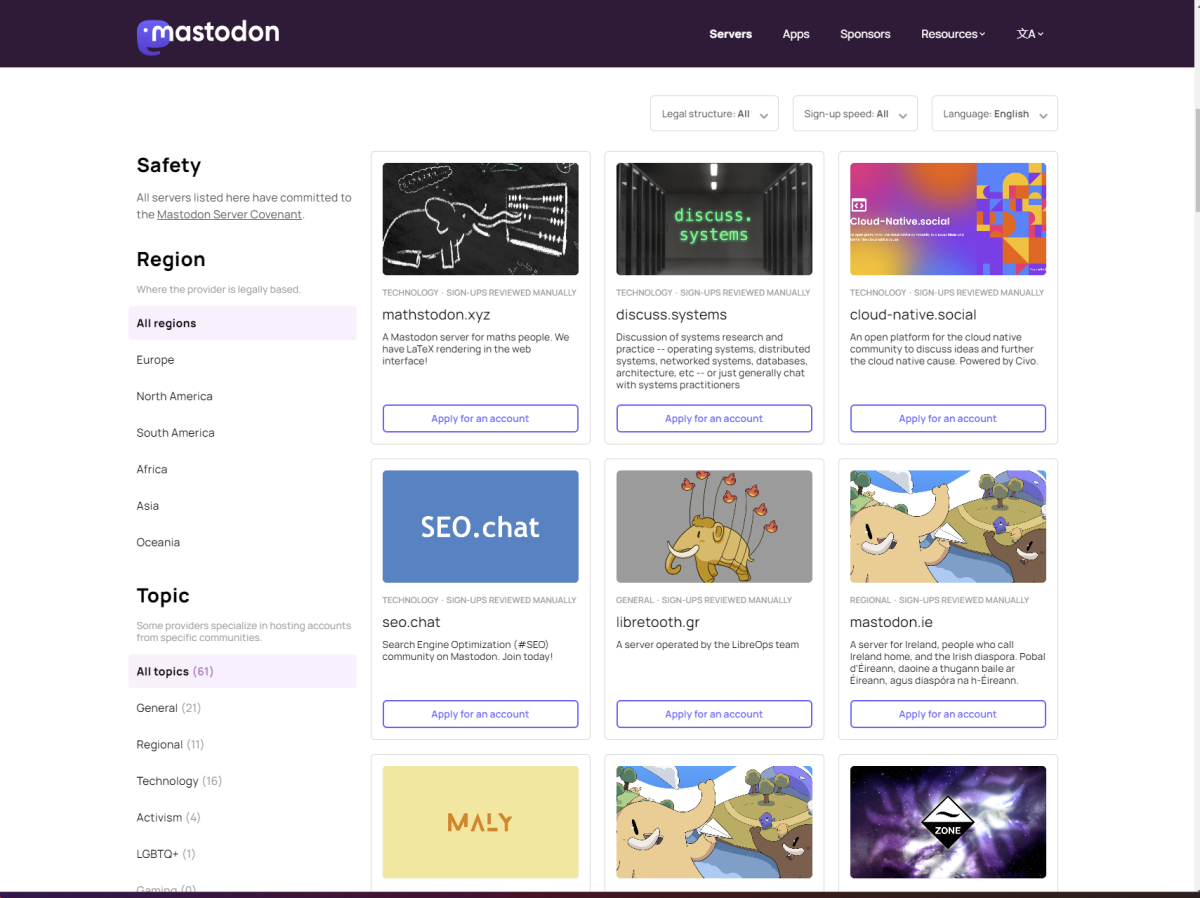
Choosing a server is the biggest point of friction for new users. There’s nothing “difficult” about signing up – it’s the same as every other website or app in steps and difficulty – but this step does act as a potential speedbump. Think of servers like clubhouses, chat rooms, or subreddits, you join them based on interests or convenience. There’s nothing wrong with joining a generic, big instance that lets you in and then moving to a smaller, more unique one as you learn and explore.
Adam Taylor/IDG
You can also move your entire profile to another instance at any time, followers and all. Which is part of the resilience of the service, too. Your previous “account” then turns into a redirect to your new one. No worries if you already told everyone your previous address, the system has free mail forwarding!
All of this means that services like Mastodon are decentralized, governed and hosted by different groups of people in different places and not subject to any individual authority or goals, resilient by nature of being decentralized and interoperable, and they give power back to the user. You, the user, are in control of your own data. You can delete every ounce of it whenever you like, move it between instances if you don’t like how the one you’re in is being run, or host your own single-user or small community instance where you make the rules! You are not the product, which is hard to wrap your mind around when the net has conditioned us into accepting being the product for over a decade now.
Also, we just went through a load of decentralization talk, and didn’t need to mention blockchain or crypto even once. Just saying.
Why people host Mastodon instances
I got a chance to speak with Joe “KuJoe” Dougherty, the operator of the mindly.social Mastodon instance, about why he started hosting it in the first place, given it went up just a little before large crowds started coming over from Twitter. His story is similar to many who have started seeking out alternative homes for social networking.
“Earlier this year I was feeling a real sense of dread using social media, it felt like a game that I could never win,” Dougherty told me. “I would spend a lot of my time on it looking for somebody to interact with but legitimate conversations were so few and far between because talking in replies doesn’t get likes.” As someone familiar with IT and server hosting, Dougherty was naturally curious about this new service and started researching it, getting hooked immediately.
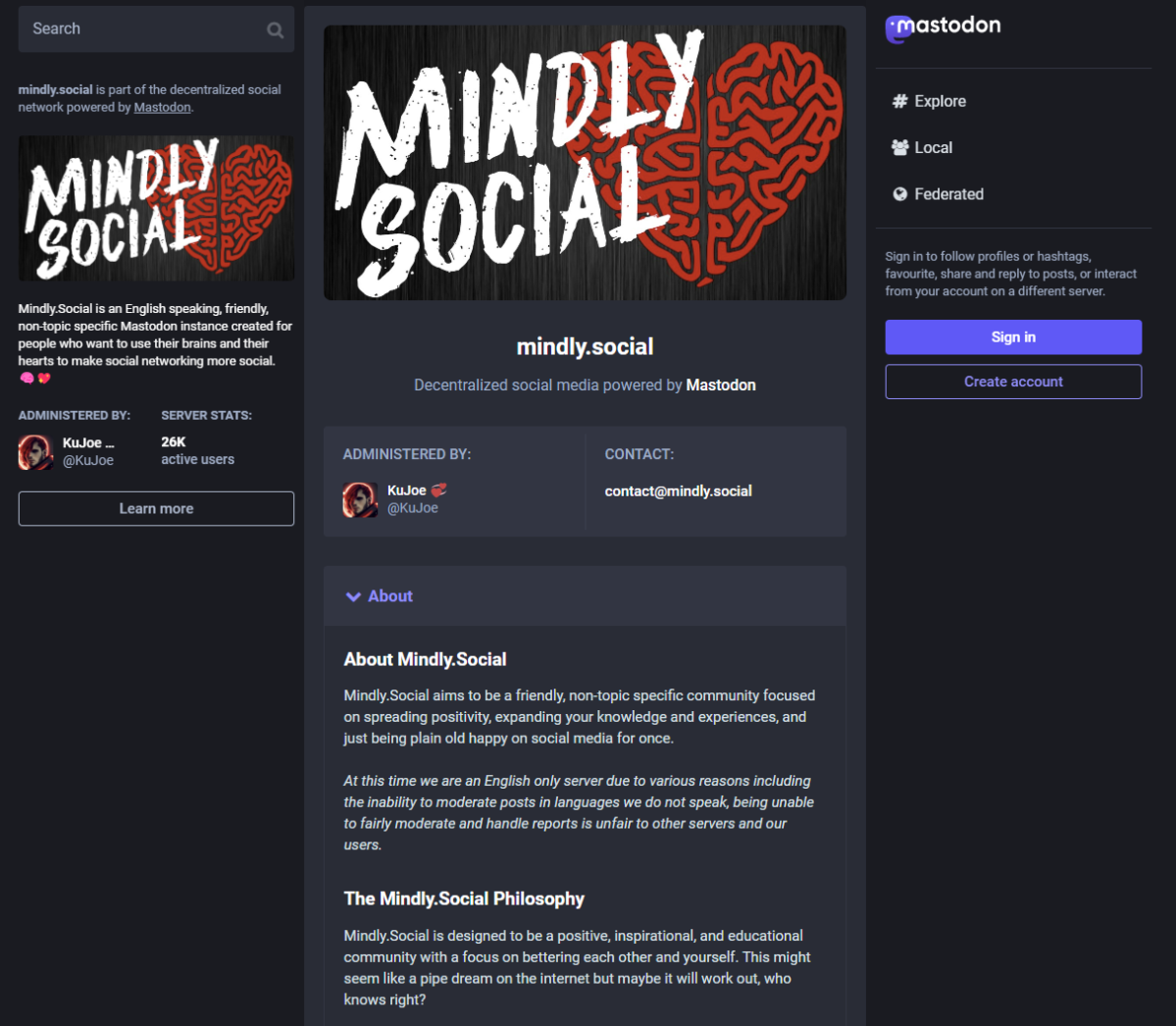
Mindly.social is one of many Mastodon instances that started out simply as a small, fun place to hang out, but quickly exploded during Mastodon’s influx of viewers in November.
Adam Taylor/IDG
“I was drawn to the tech, to the freedom from corporations, and to the social aspect of it all,” he continued. “After a bit more research I decided to start my own instance because I wanted to build a different kind of community than the existing instances while also putting my tech skills to work. It was a good feeling to offer other people a home on a new platform.” Dougherty quit most other social media not long after, being all-in on Mastodon by October, and said the change immediately improved not just his mental health, but his productivity, too.
Then, of course, the Twitter fiasco exploded interest in Mastodon in general. Being one of the few instances available to these huge waves of new users—as many instances had to pause or close invites to balance the load and allocate more resources, etc.—mindly.social saw a huge growth in community members. “November 7th we hit 100 users on our instance, then on November 8th we hit 5,000 users, then on November 10th we hit 10,000 users. 6 days later we’re sitting at around 21,000 users.”
For Dougherty, it’s hardly about the numbers, though. “I’m so glad to have a home for so many people, most of whom proudly share that they are escaping the negativity of other social media platforms like I was,” he said. “In the past few weeks I’ve had so many conversations with people just talking about random things, more than I’d ever had in the 14 years I was on Twitter. I’ve turned off notifications so I don’t see when I get favorites or boosts and I’m genuinely more happy as a result.”
“Probably the best part about this whole experience is every day it’s different people,” Dougherty said. “I didn’t just find a group of 2-3 people that grouped up with and talk with every day. Every single day for the past 9 days I’ve had meaningful interactions with new people, even if it’s just me helping them get situated and we make little jokes while we work through it. Even outside of the conversations, every single day people are posting fantastic artwork, beautiful photos, inspirational quotes and poems, and just overall interesting stuff. Social media truly is much better when there’s no algorithm to get in your way.”
Kicking it old school
Again: The Internet used to be this way to begin with. Socializing online meant chatting on different BBS or forums hosted in different places by different groups of people, usually funded by that community. It meant staying up late using Pidgin or Trillian to keep track of AIM, MSN, and Yahoo instant messaging accounts to keep up with friends in different places. It meant having fansites running their own shows, and blogs spread out across Blogspot, Geocities, and so on—rather than everything being limited to Facebook groups and Twitter circles, where you’re constantly fed ads, your data is harvested and sold, and the for-profit corporations running them are making decisions about how to extend profits rather than provide a great service.
But with all of this momentum towards federated and alternative services, and millions of users finally trying this stuff out, it all means we might actually be able to reclaim the Internet back for the users.
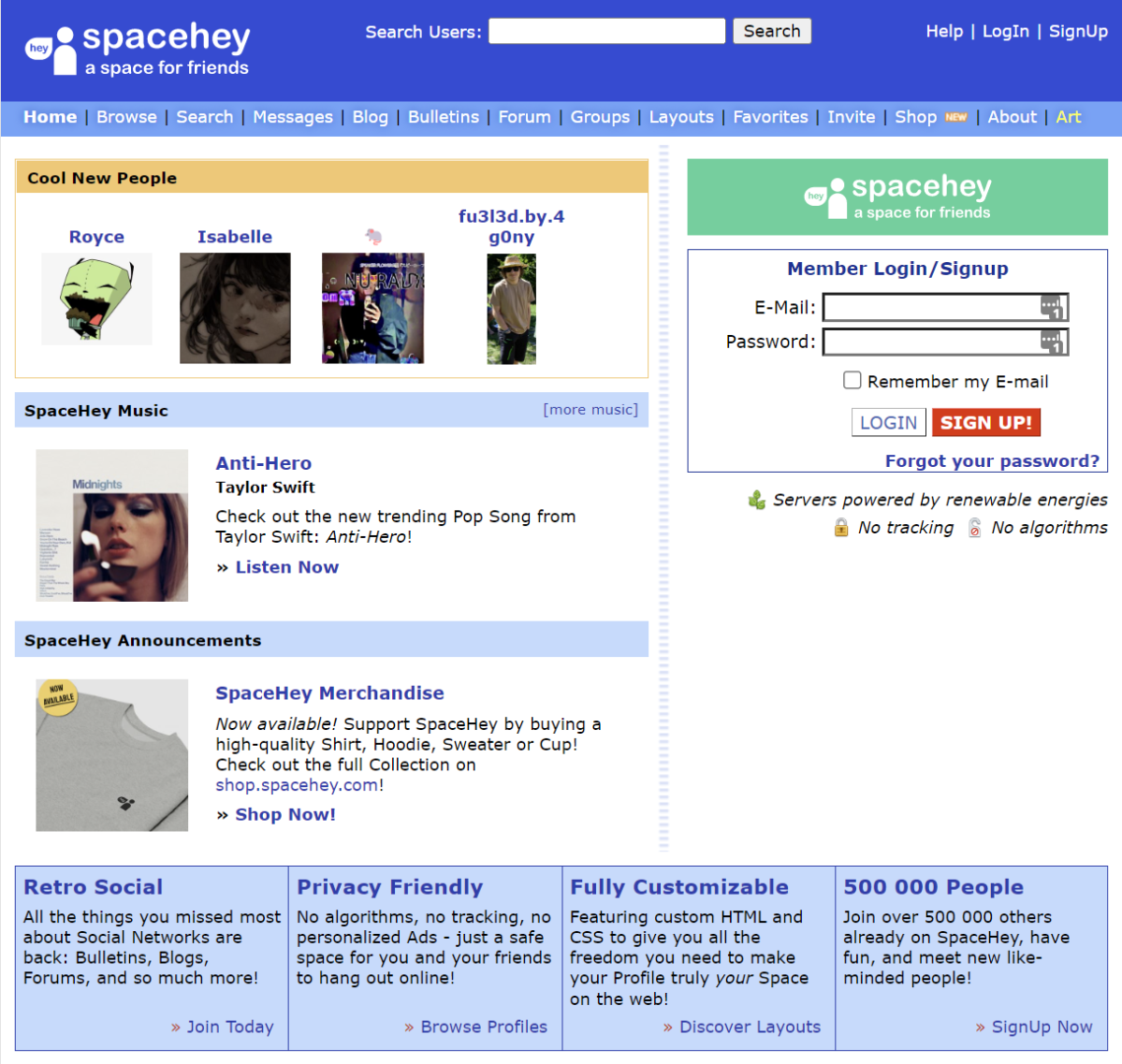
While it’s not a federated service connected to Mastodon, SpaceHey is another great example of a small, alternative social networking website that’s independently-run and happens to help harken back to the classic MySpace Nostalgia.
Adam Taylor/IDG
If you don’t find yourself enjoying Mastodon, that’s okay! The goal of this “shift” is not to convert you over to another service to monopolize your time, but rather to get you to try out smaller services and communities that might be a better fit for you. Let’s take a look at a few more while we’re at it.
PixelFed
Another great Fediverse service is Pixelfed, a Instagram clone with all the same priorities and subversion of Mastodon. You can share photos and images, you can like, comment, and re-share posts, use filters, add Stories (sigh), build albums, DM users, and so on. There are also no ads, no data selling, and no algorithms. I still think a no-comments photo app like Glass would be more akin to what I want as a “pure” art tool, but this is awesome.
Since it’s federated, you can view, follow, and interact with PixelFed posts and accounts with your existing Mastodon account! Creating posts does require you to make a new, PixelFed-specific account, which is a point of confusion for users. But then your PixelFed feed becomes its own federated profile that you can, for example, follow on Mastodon to easily boost and share your PixelFed posts to your existing Mastodon followers.
PeerTube
If you want to host videos, PeerTube is a great service for building that. It’s decentralized, open source, and uses ActivityPub for federation—meaning that instead of just building one massive and direct “YouTube competitor” (which has historically not been a successful venture: See VidMe, Vessel, etc.), individual communities or organizations can host their own video websites for specific topics or communities.
A great example of this is TILvids, a video site ran on PeerTube that’s dedicated to edutainment videos (hence the “Today I Learned” acronym in the title).
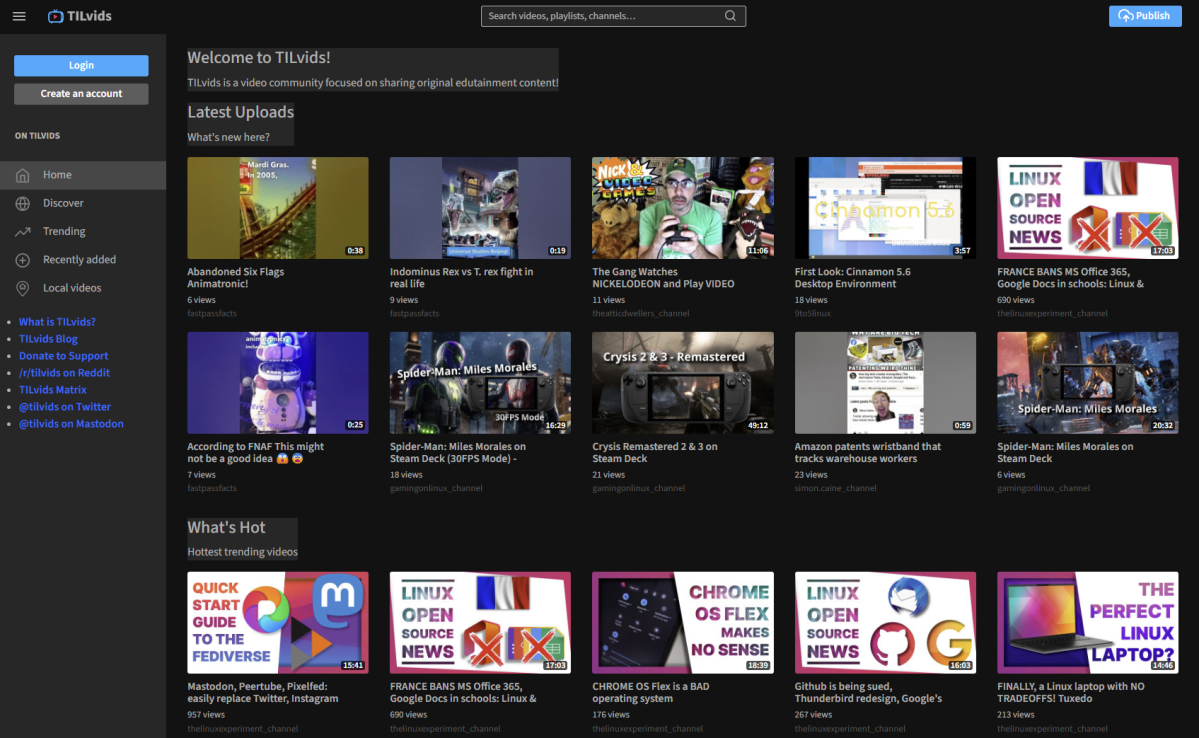
Adam Taylor/IDG
This has many advantages, including lower and more spread-out costs by not putting the bulk of it on any individual or singular organization, easier discoverability by having specialized sites for individual niches or communities, and control for organizations or groups who want to host their own content without being restricted in rules by a higher authority. Plus, all the usual advantages of decentralization and federation described above.
PeerTube uses the Bittorrent peer-to-peer protocol for streaming video to help reduce bandwidth costs and load, too.
Owncast
Beyond just on-demand videos, you can use Owncast for hosting your own live streaming service with control over how things are run, no ads (unless you integrate them), chat with chat bots, and compatibility with most streaming software. For streamers wanting to reduce their dependence on a specific streaming platform, running Owncast is a great way to give viewers somewhere else to support you without missing any of the action.
WriteFreely
For long-form writers, WriteFreely is a minimal, Markdown-based blogging service that can be as private or public as you want, with intense customization options. You can craft private personal journals or publish blogs with monetization, complete with (optional) comments and federation to other ActivityPub-enabled services as well. You can also set up your own blog on existing WriteFreely community servers like Write.as or easily host your own! Better yet, it’s easy to run.
Tumblr?
Believe it or not, blogging platform Tumblr is on the rise again after being sold to Automattic (WordPress’ parent company) in 2019. While it’s not currently a federated service, Automattic CEO Matt Mullenweg teased, then later confirmed that Tumblr will be integrating ActivityPub into the blogging platform and working on interoperability with other federated services (like Mastodon) once they scale up to handle the new wave of migrating Twitter users.
The Universe Expands Infinitely
This only included a brief overview of federated services available. More examples include:
- BookWyrm for a nice alternative to GoodReads
- Lemmy, a link discussion service like Reddit
- friendica, a direct friendship manager service
- Funkwhale, for music sharing and discussion
Make the net weird again
Regardless of what direction Twitter goes in, it seems the social networking landscape on the Internet is changing, potentially for the better—starting with just having services that are “social networking” instead of “social media” to begin with.
You don’t need to make drastic moves or jump ship from any services right now, but familiarizing yourself with these decentralized options will only benefit you as things move forward. We can all benefit from a paradigm shift back away from users being the product, and towards gaining control over our online experiences. The internet used to be a fun place full of clubhouses run by people with varying interests, but more recently it’s just been big, monolithic office buildings run by corporations and billionaires. Let’s take the internet back and make the net weird again.
I’m still setting up other Fedi services (including my own instance I’m super stoked for), but in the meantime you can find me on Mastodon at @[email protected] and my WriteFreely blog at AnalogDreams.blog.
Stay connected with us on social media platform for instant update click here to join our Twitter, & Facebook
We are now on Telegram. Click here to join our channel (@TechiUpdate) and stay updated with the latest Technology headlines.
For all the latest Technology News Click Here
For the latest news and updates, follow us on Google News.
